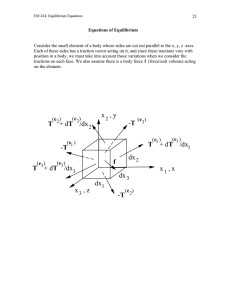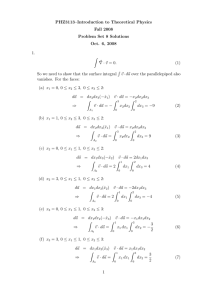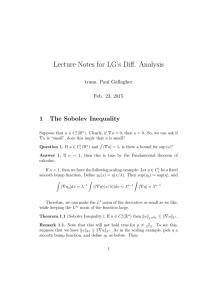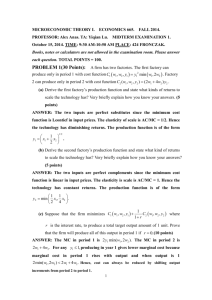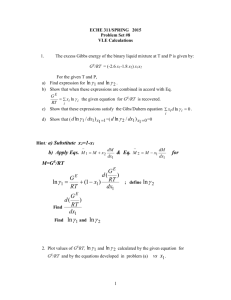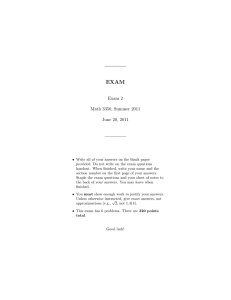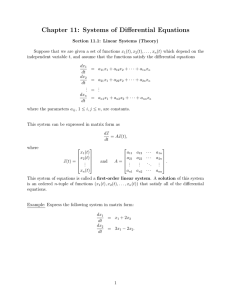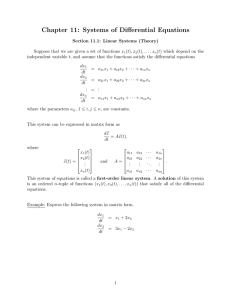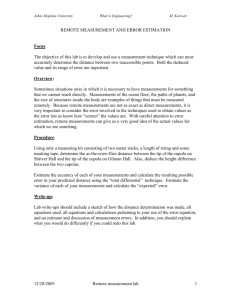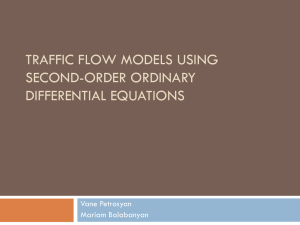WEIGHTED INEQUALITIES FOR THE SAWYER TWO-DIMENSIONAL HARDY OPERATOR
advertisement
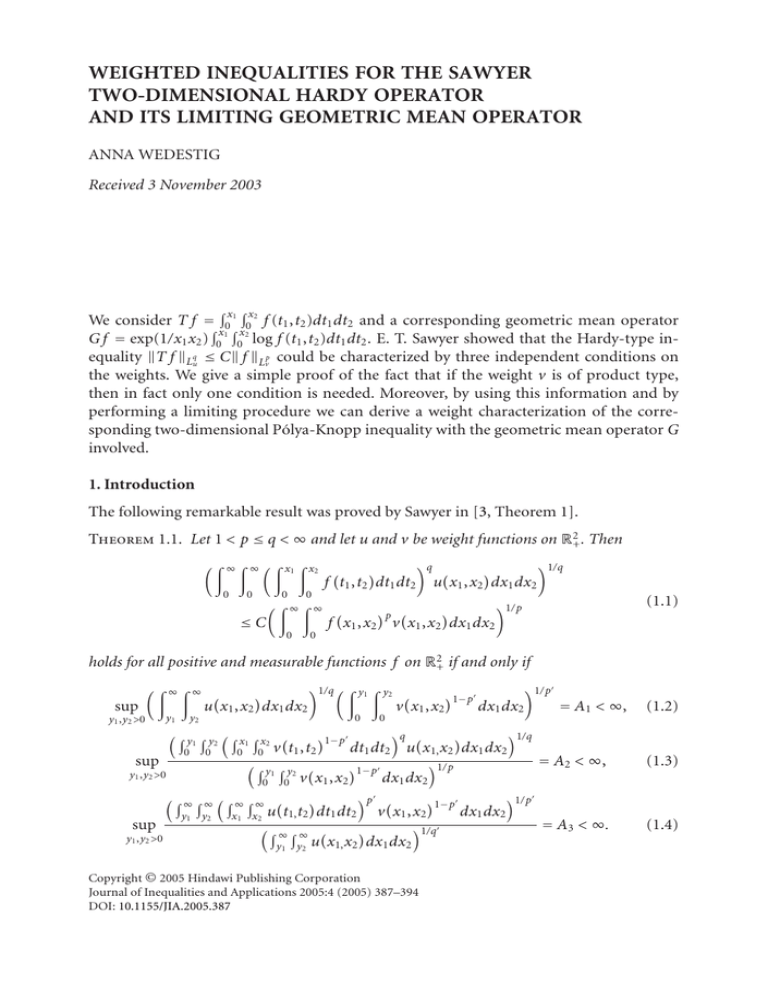
WEIGHTED INEQUALITIES FOR THE SAWYER TWO-DIMENSIONAL HARDY OPERATOR AND ITS LIMITING GEOMETRIC MEAN OPERATOR ANNA WEDESTIG Received 3 November 2003 x x We consider T f = 0 1 0 2 f (t1 ,t2 )dt1 dt2 and a corresponding geometric mean operator x x G f = exp(1/x1 x2 ) 0 1 0 2 log f (t1 ,t2 )dt1 dt2 . E. T. Sawyer showed that the Hardy-type inequality T f Luq ≤ C f Lvp could be characterized by three independent conditions on the weights. We give a simple proof of the fact that if the weight v is of product type, then in fact only one condition is needed. Moreover, by using this information and by performing a limiting procedure we can derive a weight characterization of the corresponding two-dimensional Pólya-Knopp inequality with the geometric mean operator G involved. 1. Introduction The following remarkable result was proved by Sawyer in [3, Theorem 1]. Theorem 1.1. Let 1 < p ≤ q < ∞ and let u and v be weight functions on R2+ . Then ∞ ∞ x1 x2 0 0 0 ≤C 0 ∞ ∞ 0 q f t1 ,t2 dt1 dt2 0 1/q u x1 ,x2 dx1 dx2 p (1.1) 1/ p f x1 ,x2 v x1 ,x2 dx1 dx2 holds for all positive and measurable functions f on R2+ if and only if ∞ ∞ sup y1 ,y2 >0 y1 y2 y1 y2 0 0 sup 1/q y1 y2 u x1 ,x2 dx1 dx2 y1 ,y2 >0 y1 ,y2 >0 y1 y2 0 1− p 1/ p dx1 dx2 q 1/q 1− p x1 x2 dt1 dt2 u x1, x2 dx1 dx2 0 0 v t1 ,t2 1/ p 1− p y1 y2 dx1 dx2 0 0 v x1 ,x2 = A1 < ∞, (1.2) ∞ ∞ ∞ ∞ sup 0 v x1 ,x2 x1 x2 u t1, t2 dt1 dt2 ∞ ∞ y1 p v x1 ,x2 y2 u x1, x2 dx1 dx2 1− p 1/q Copyright © 2005 Hindawi Publishing Corporation Journal of Inequalities and Applications 2005:4 (2005) 387–394 DOI: 10.1155/JIA.2005.387 dx1 dx2 = A2 < ∞, (1.3) = A3 < ∞. (1.4) 1/ p 388 Two-dimensional Hardy inequality However in [4] it was proved that to characterize the two-dimensional Pólya-Knopp inequality ∞ ∞ exp 0 0 ≤C ∞ ∞ 0 x1 x2 1 x1 x2 f 0 0 q log f t1 ,t2 dt1 dt2 0 p 1/q u x1 ,x2 dx1 dx2 (1.5) 1/ p x1 ,x2 v x1 ,x2 dx1 dx2 for 0 < p ≤ q < ∞, only one condition was needed. An interesting observation is that this inequality can be characterized by just using one integral condition even if the inequality seems to be a natural limiting inequality of the Sawyer result mentioned above. The aim of this paper is to find a two-dimensional weight characterization that allow us to perform a limiting procedure (as in [2, 4]), and receive a weight characterization of the corresponding two-dimensional Pólya-Knopp inequality (1.5). From the corresponding result in one dimension (see [2, 4]), we know that this requires special homogeneity properties of the conditions that for instance the condition (1.2) doesn’t have. On the other hand the fact that (1.5) is equivalent to a one-weighted Pólya-Knopp inequality makes it possible for us to use an Hardy inequality where we allow one weight to be of product type and thus characterize the Hardy inequality with only one condition and with the special homogeneity properties (see Section 2). In Section 3 we will also show that with that condition and the corresponding estimates of the best constant we will, by performing a limiting procedure (as in [2, 4]), receive exactly the same condition and estimate of the best constant C for the weighted two dimensional Pólya-Knopp inequality (1.5) as in [4]. 2. A two-dimensional Hardy-type inequality Our main result reads. Theorem 2.1. Let 1 < p ≤ q < ∞, s1 ,s2 ∈ (1, p), let u be a weight function on R2+ and let v1 and v2 be weight functions on R+ . Then the inequality ∞ ∞ x1 x2 0 0 0 ≤C 0 ∞ ∞ 0 q f t1 ,t2 dt1 dt2 f 0 p 1/q u x1 ,x2 dx1 dx2 (2.1) 1/ p x1 ,x2 v1 x1 v2 x2 dx1 dx2 holds for all measurable functions f ≥ 0 if and only if (s1 −1)/ p AW s1 ,s2 = sup V1 t1 (s2 −1)/ p V2 t2 t1 ,t2 >0 × where V1 (t1 ) = t1 0 ∞ ∞ t1 t2 q((p−s1 )/ p) u x1, x2 V1 x1 q((p−s2 )/ p) V2 x 2 1/q dx1 dx2 < ∞, (2.2) v1 (x1 )1− p dx1 and V2 (t2 ) = t2 0 v2 (x2 )1− p dx2 . Anna Wedestig 389 Moreover, if C is the best possible constant in (2.1), then 1<s1 ,s2 <p sup p ≤C≤ inf AW s1 ,s2 1<s1 ,s2 <p 1/ p p/ p − s1 p p/ p − s1 + 1/ s1 − 1 p p/ p − s2 p p/ p − s2 + 1/ s2 − 1 1/ p AW s1 ,s2 p − 1 1/ p p − 1 1/ p . p − s1 p − s2 (2.3) For the proof of Theorem 2.1 we need the following Minkowski inequality (see [4]). Lemma 2.2. Let r > 1, −∞ ≤ a1 < b1 ≤ ∞, −∞ ≤ a2 < b2 ≤ ∞ and let Φ and Ψ be positive measurable functions on [a1 ,b1 ] × [a2 ,b2 ]. Then b1 b2 a1 a2 ≤ Φ x1 ,x2 b1 b2 a1 a1 x1 x2 a1 Ψ t1 ,t2 a2 r Ψ t1 ,t2 dt1 dt2 dx1 dx2 b1 b2 t1 t1 Φ x1 ,x2 dx1 d2 1/r (2.4) 1/r dt1 dt2 . Proof of Theorem 2.1. Let f p (x1 ,x2 )v1 (x)v2 (x2 ) = g(x1 ,x2 ) in (2.1). Then (2.1) is equivalent to the inequality ∞ ∞ x1 x1 0 0 0 ≤C g t1 ,t2 0 ∞ ∞ 0 v1 t1 v2 t2 dt1 dt2 1/q u x1 ,x2 dx1 dx2 (2.5) 1/ p g x1 ,x2 dx1 dx2 0 q 1/ p −1/ p −1/ p . Assume that (2.2) holds. By applying Hölder’s inequality, the fact that (d/dt1 )V1 (t1 ) = v1 (t1 )1− p = v1 (t1 )− p / p , (d/dt2 )V2 (t2 ) = v2 (t2 )1− p = v2 (t2 )− p / p and Lemma 2.2 we have ∞ ∞ x1 x2 0 = 0 0 0 g t1 ,t2 ∞ ∞ x1 x2 0 0 0 0 1/ p −1/ p −1/ p v1 t1 g t1 ,t2 1/ p v2 t2 (s1 −1)/ p V1 t1 q dt1 dt2 (s2 −1)/ p ∞ ∞ x1 x2 0 × × 0 x1 0 x2 0 p−1 = p − s1 0 0 s 1 −1 g t1 ,t2 V1 t1 −(s1 −1)p / p − p / p V1 t1 v1 t1 −(s2 −1)p / p − p / p V2 t2 1/ p v2 t2 p−1 p − s2 −(s1 −1)/ p −1/ p V1 t1 v1 t1 1/q u x1 ,x2 dx1 dx2 s2 −1 V2 t2 q/ p dt1 dt2 q/ p dt1 q/ p dt2 0 0 0 s1 −1 g t1 ,t2 V1 t1 q((p−s1 )/ p) × V1 x 1 1/q u x1 ,x2 dx1 dx2 1/ p ∞ ∞ x1 x2 0 q 1/q u x1 ,x2 dx1 dx2 V2 t2 −(s2 −1)/ p −1/ p × V2 t2 v2 t2 dt1 dt2 ≤ s2 −1 V2 t2 q((p−s2 )/ p) V2 x 2 q/ p dt1 dt2 u x1 ,x2 dx1 dx2 1/q 390 Two-dimensional Hardy inequality 1/ p p−1 ≤ p − s1 × p−1 ≤ p − s1 p−1 p − s2 1/ p ∞ ∞ 0 ∞ ∞ t1 q((p−s1 )/ p) V1 x 1 t2 1/ p 0 p−1 p − s2 1/ p s1 −1 g t1 ,t2 V1 t1 AW s1 ,s2 s2 −1 V2 t2 q((p−s2 )/ p) V2 x 2 ∞ ∞ 0 p/q u x1 ,x2 dx1 dx2 1/ p g t1 ,t2 dt1 dt2 0 1/ p dt1 dt2 . (2.6) Hence (2.5) and, thus, (2.1) holds with a constant satisfying the right-hand side inequality in (2.3). Now we assume that (2.1) and, thus, (2.5) holds and choose the test function g x1 ,x2 = p p p − s1 −s1 × V1 t1 p + p p p − s2 1− p v1 x1 p −s1 V1 t1 −s 2 V2 t2 1− p v2 x2 1− p v1 x1 χ(0,t1 ) x1 χ(0,t2 ) x2 −s2 V2 x 2 1− p v2 x2 χ(0,t1 ) x1 χ(t2 ,∞) x2 p − s1 p −s 1− p −s2 1− p p + V1 x1 1 v1 x1 V2 t2 v2 x2 χ(t1 ,∞) x1 χ(0,t2 ) x2 p − s2 −s1 + V1 x 1 1− p v1 x1 −s2 V2 x 2 1− p v2 x2 χ(t1 ,∞) x1 χ(t2 ,∞) x2 , (2.7) where t1 , t2 are fixed numbers > 0. Then the integral on right-hand side of (2.5) can be estimated as follows: ∞∞ 0 0 = t1 p p −s1 V1 t1 1− p v1 x1 t2 dx1 p p −s 2 V2 t2 1− p v2 x2 p − s1 p − s2 0 t1 ∞ p −s 1− p p −s 1− p + V1 t1 1 v1 x1 dx1 V2 x2 21 v2 x2 dx2 p − s1 0 t2 ∞ t2 p −s 1− p −s 1− p p + V1 x1 1 v1 x1 dx1 V2 t2 2 v2 x2 dx2 p − s2 t1 0 0 ∞ + ≤ 1/ p g x1 ,x2 dx1 dx2 t1 −s1 V1 x 1 p p − s1 p + 1− p v1 x1 1 s1 − 1 1/ p ∞ dx1 t2 p p − s2 −s2 V2 x 2 p + 1 s2 − 1 1− p v2 x2 1/ p 1/ p dx2 (1−s1 )/ p V1 t1 dx2 (1−s2 )/ p V2 t2 . (2.8) Anna Wedestig 391 Moreover, the left-hand side of (2.5) is greater than ∞ ∞ t1 t1 t2 0 −s1 / p p p − s1 t1 + t1 + × x2 p −s1 / p 1− p −s1 / p 1− p −s2 / p 1− p v1 y1 V2 y 1 t2 = ··· = v1 y1 V1 y 1 t1 v1 y1 v2 y2 ∞ ∞ p 1− p V1 t1 V1 y 1 x1 v1 y1 −s1 / p p p − s1 0 x1 + V1 t1 p − s1 p − s2 t1 t2 t2 d y1 p p − s2 x2 0 1− p d y1 t2 t2 d y1 1− p −s2 / p 1− p −s2 / p 1− p V2 y 1 p p − s2 0 −s2 / p V2 t2 v2 y2 v2 y2 V2 t2 v2 y2 d y2 d y2 d y2 d y1 q d y2 1/q u x1 ,x2 dx1 dx2 q((p−s1 )/ p) u x1, x2 V1 x1 q((p−s2 )/ p) V2 x 2 1/q dx1 dx2 . (2.9) Hence, (2.5) implies that ∞ ∞ p p p − s1 p − s2 t1 ≤C p t2 p + p − s1 q((p−s1 )/ p) u x1, x2 V1 x1 1 1/ p s1 − 1 p q((p−s2 )/ p) V2 x 2 p p − s2 + 1 1/ p 1/q dx1 dx2 (1−s1 )/ p V1 t1 s2 − 1 V2 (t2 )(1−s2 )/ p , (2.10) that is, that p p/ p − s1 p p/ p − s1 +1/ s1 − 1 × ∞ ∞ t1 t2 1/ p p p/ p − s2 p p/ p − s2 +1/ s2 − 1 q((p−s1 )/ p) q((p−s2 )/ p) u x1, x2 V1 x1 1/ p V x2 dx1 dx2 (s1 −1)/ p V1 t1 (s2 −1)/ p V2 t2 1/q ≤ C. (2.11) We conclude that (2.2) and the left-hand side of the estimate of (2.3) hold. The proof is complete. 3. A two-dimensional Pólya-Knopp inequality Here, we will give another proof of two-dimensional Pólya-Knopp inequality (1.5) proved in [4] by proving that this theorem is just the natural limit result of our theorem (Theorem 2.1). 392 Two-dimensional Hardy inequality Theorem 3.1 [4]. The inequality (1.5) holds for all positive and measurable functions on R2+ if and only if DW (s1, s2 ) := sup y1(s1 −1)/ p y2(s2 −1)/ p ∞ ∞ y1 y1 >0 y2 >0 −s1 q/ p −s2 q/ p x1 y2 x2 1/q < ∞, w x1 ,x2 dx1 dx2 (3.1) where s1 ,s2 > 1 and w x1 ,x2 = exp 1 x1 x2 x1 x2 0 0 1 dt1 dt2 log v t1 ,t2 q/ p u x1 ,x2 (3.2) and the best possible constant C in (1.5) can be estimated in the following way: sup s1 ,s2 >1 1/ p es1 s1 − 1 s 1 e s1 − 1 + 1 1/ p es2 s2 − 1 s 2 e s2 − 1 + 1 DW s1 ,s2 (3.3) ≤ C ≤ inf e(s1 +s2 −2)/ p DW s1 ,s2 . s1 ,s2 >1 Remark 3.2. For the case p = q = 1, a similar result was recently proved by Heinig, Kerman and Krbec [1] but without the estimates of the operator norm (= the best constant C in (1.5)) pointed out in (3.3) here. Proof of Theorem 3.1. If we in the inequality (1.5) replace f p (x1 ,x2 )v(x1 ,x2 ) with f p (x1 , x2 ) and let w(x1 ,x2 ) be defined as in (3.2), then (1.5) is equivalent to ∞ ∞ exp 0 0 ≤C 1 x1 x2 ∞ ∞ 0 0 f x1 x2 0 0 p q log f y1 , y2 d y1 d y2 1/q w x1 ,x2 dx1 dx2 (3.4) 1/ p x1 ,x2 dx1 dx2 . −q −q Further, by using Theorem 2.1 with the special weights u(x1 ,x2 ) = w(x1 ,x2 )x1 x2 and v1 (x1 ) = v2 (x2 ) = 1 we have that ∞ ∞ 0 0 ≤C 1 x1 x2 x1 x2 0 ∞ ∞ 0 0 q f t1 ,t2 dt1 dt2 0 1/q w x1 ,x2 dx1 dx2 (3.5) 1/ p f p x1 ,x2 dx1 dx2 holds for all f ≥ 0 if and only if (s −1)/ p (s2 −1)/ p t2 AW s1 ,s2 = sup t1 1 t1 ,t2 >0 ∞ ∞ t1 t2 −s1 q/ p −s2 q/ p w x1, x2 x1 x2 1/q dx1 dx2 < ∞, (3.6) Anna Wedestig 393 where s1 ,s2 ∈ (1, p). We note that AW (s1 ,s2 ) coincides with the constant DW (s1 ,s2 ) = DW (s1 ,s2 , q, p) defined by (3.1). Moreover, if C is the best possible constant in (3.5), then 1<s1 ,s2 <p sup p p/ p − s1 p p/ p − s1 + 1/ s1 − 1 ≤C≤ inf DW s1 ,s2 1<s1 ,s2 <p 1/ p p p/ p − s2 p p/ p − s2 + 1/ s2 − 1 1/ p DW s1 ,s2 p − 1 1/ p p − 1 1/ p . p − s1 p − s2 (3.7) Now, if we replace f in (3.5) with f α , 0 < α < p and after that replace p with p/α and q with q/α in (3.5), (3.6), and (3.7), then we find that, for 1 < s1 ,s2 < p/α, ∞ ∞ 0 0 ≤ Cα 1 x1 x2 x1 x2 0 0 ∞ ∞ 0 0 f p q/α f α t1 ,t2 dt1 dt2 1/q w x1 ,x2 dx1 dx2 (3.8) 1/ p x1 ,x2 dx1 dx2 α (s1 ,s2 , q, p) < ∞. Moreover, if holds for all f ≥ 0 if and only if DW (s1 ,s2 , q/α, p/α) = DW Cα is the best possible constant in (3.8), then sup 1<s1 ,s2 <p/α p/α p/ p − αs1 p p/ p − αs1 +1/ s1 − 1 ≤ Cα ≤ α DW s1 ,s2 , q, p inf 1<s1 ,s2 <p/α 1/ p p/α p/ p − αs2 p p/ p − αs2 + 1/ s2 − 1 1/ p p−α p − αs1 (p−α)/αp p−α p − αs2 α DW s1 ,s2 , q, p (p−α)/αp . (3.9) We also note that 1 x1 x2 x1 x2 0 0 1/α f α t1 ,t2 dt1 dt2 ↓ exp 1 x1 x2 x1 x2 0 0 ln f t1 ,t2 dt1 dt2 , as α −→ 0+ . (3.10) We conclude that (3.1) holds exactly when limsupα→0+ Cα < ∞ and this holds, according to (3.9), exactly when (3.6) holds. Moreover, when α → 0+ (3.9) implies that the upper estimate in (3.3) holds. For the lower estimate we apply the following testfunction (c.f. [4]): For fixed t1 and t2 , t1 ,t2 > 0, let g x1 ,x2 = g0 x1 ,x2 = t1−1 t2−1 χ(0,t1 ) x1 χ(0,t2 ) x2 s −1 e−s2 t22 + t1−1 χ(0,t1 ) x1 x2s2 + e−s1 t1s1 −1 χ(t1 ,∞) x1 t2−1 χ(0,t2 ) x2 s1 x1 + e−(s1 +s2 ) t1s1 −1 t22 x1s1 x2s2 s −1 The proof is complete. χ(t2 ,∞) x2 (3.11) χ(t1 ,∞) x1 χ(t2 ,∞) x2 . 394 Two-dimensional Hardy inequality Remark 3.3. This proof shows that the Pólya-Knopp inequality (1.5) characterized in Theorem 3.1 may be regarded as a natural limiting inequality of the (Sawyer type) Hardy inequality characterized in Theorem 2.1. Acknowledgment I thank Professor L. E. Persson for some valuable suggestions which have improved the final version of this paper. References [1] [2] [3] [4] H. P. Heinig, R. Kerman, and M. Krbec, Weighted exponential inequalities, Georgian Math. J. 8 (2001), no. 1, 69–86. L.-E. Persson and V. D. Stepanov, Weighted integral inequalities with the geometric mean operator, J. Inequal. Appl. 7 (2002), no. 5, 727–746, An abbreviated version can also be found in Russian Akad. Sci. Dokl. Math. 63 (2001), 201-202. E. Sawyer, Weighted inequalities for the two-dimensional Hardy operator, Studia Math. 82 (1985), no. 1, 1–16. A. Wedestig, Some new Hardy type inequalities and their limiting inequalities, JIPAM. J. Inequal. Pure Appl. Math. 4 (2003), no. 3, 1–15, Article 61. Anna Wedestig: Department of Mathematics, Luleå University, 97 187 Luleå, Sweden E-mail address: annaw@sm.luth.se
